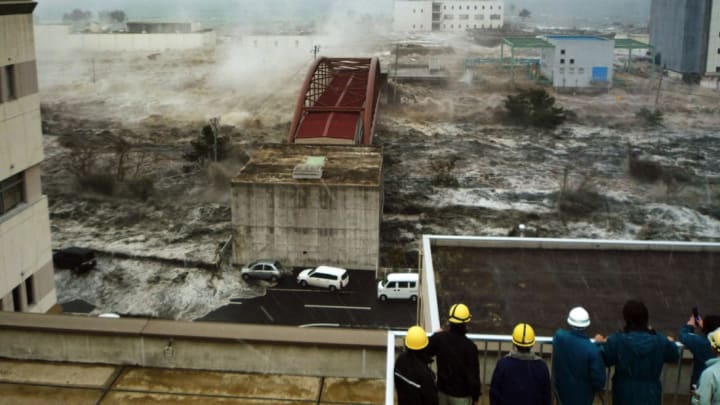Tsunamis have been wreaking havoc on the world's coastlines for centuries. Since 1850 alone, tsunamis have been responsible for taking 420,000 lives and causing billions of dollars in damage. How do these monster waves work?
DON'T CALL IT A TIDAL WAVE
Tsunamis have nothing to do with the wind-generated waves we're used to seeing, or the tides—they’re a set of ocean waves caused by the rapid displacement of water. Most commonly, this happens when large underwater earthquakes push up the seabed; the larger and shallower the earthquake, the bigger the potential tsunami. Once generated, the waves split: A distant tsunami travels out into the open ocean, while a local tsunami travels toward the nearby coast. The speed of the waves depends on the depth of the water, but typically, waves roll across the ocean at speeds between 400 and 500 mph.
It’s not only the method of generation that differentiates tsunamis from wind-generated waves. On average, wind waves have a crest-to-crest wavelength—the distance over which the wave’s shape repeats—of approximately 330 feet and a height of 6.6 feet. A deep ocean tsunami will have a wavelength of 120 miles and amplitude (the distance from the peak of the wave to its trough) of only about 3.3 feet. This is why tsunamis are difficult to detect in the open ocean.
More Articles About Tsunamis:
As a tsunami approaches the shore, the wave compresses: Its speed and wavelength decrease while its amplitude grows enormously. Most waves arrive on-shore not as a huge wave but as a fast-moving tidal bore that floods the shoreline. However, if the trough of the wave arrives before the ridge, or peak, the sea will recede from the shore, exposing normally submerged areas, as the trough builds into a ridge. This can serve as a brief warning that a tsunami is about to occur.
Other causes of tsunamis include underwater landslides and explosions. Another type of wave, called a mega-tsunami, is caused by above-water landslides or glacier calving. The largest recorded mega-tsunami struck in Alaska’s Lituya Bay in 1958; an earthquake triggered a landslide that displaced so much water that the waves created were 470 feet taller than the Empire State Building.
MONITORING WAVES
Like earthquakes, tsunamis can’t be predicted—but that doesn’t mean scientists aren’t trying to figure out ways to warn people before the flooding starts. Using a system of buoys called DART—Deep-Ocean Assessment and Reporting of Tsunamis—researchers can monitor ocean wave height in real time. When an earthquake occurs that scientists believe is likely to trigger a tsunami, these strategically placed buoys send reports on sea level change back to tsunami warning centers. There, scientists use that data to create a model of the potential tsunami’s effects and decide whether to issue a warning or make populations evacuate.
In the 2012 action film Battleship, the DART system took a star turn. Director Peter Berg used it as a method of creating the game’s iconic grid. (The Hollywood version of DART is much more robust than the real-world version, which has just 39 buoys.)
LOCATION, LOCATION, LOCATION
Tsunamis are mostly generated by quakes that occur in subduction zones: areas where denser oceanic plates slide underneath lighter continental plates, causing vertical displacement of the seafloor and water column above it. The majority of the world's subduction zones are in the Pacific Ocean bordering Oceania, Asia, North America, and South America. This highly unsettled loop is nicknamed the "ring of fire" for its concentration of geologic upheavals.
Because the Atlantic Ocean has far fewer subduction zones than the Pacific, Atlantic tsunamis are rare, but possible. The most likely cause would be an earthquake creating a submarine landslide that would displace a huge volume of water and trigger the wave.
In 2001, geophysicists Steven N. Ward and Simon Day suggested that an Atlantic mega-tsunami could be generated by a massive landslide off La Palma, the most active volcano in the Canary Islands archipelago. The theory was based on modeling a number of worst-case scenarios, the authors said. Others have argued that the danger is overblown.
